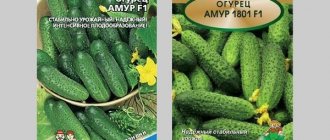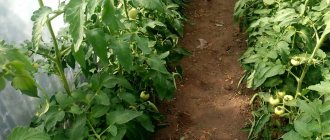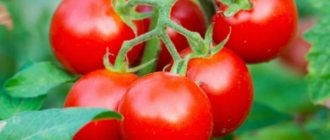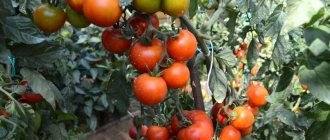How the variety was developed
The Rocket tomato was developed by Russian breeders A. N. Lukyanchenko and S. F. Gavrish, who worked at an experimental station located in Crimea at the end of the third quarter of the last century. The variety was tested at experimental sites for several years and was included in the State Register of Agricultural Achievements in 1980.
At the same time, it was recommended to grow the Raketa tomato in the south of the country in open ground in garden beds, and in more northern regions - in film greenhouses or greenhouse conditions.
Useful recommendations and advice from gardeners
In order for a tomato variety to be able to please with high yields, you should follow several rules and take into account the recommendations of experienced gardeners:
- At the time of planting, the seedlings must be fresh, otherwise the bush will be greatly retarded in growth and the first flowering may fall off.
- In order for the fruits to set and ripen quickly, regular foliar feeding of the crop is necessary during the period of active growth.
- To improve ventilation of the lower part of the bush, you need to remove side shoots and leaves from time to time.
- Rocket tomato is a sun-loving crop. The vegetable is planted in well-lit plantations.
- The nuances of crop rotation should be observed: tomatoes are planted after cucumbers, cabbage and carrots. The tomato does not develop well in beds where eggplants and potatoes were grown the previous year.
- Young plants are planted in prepared holes: humus and superphosphate are poured into them. Fertilizers will allow the crop to quickly take hold and begin to grow.
- The bushes are planted vertically and not deep. Excessive root penetration will cause the plant to rot. The soil at the roots becomes slightly compacted.
- The optimal time for planting seedlings is a cloudy day or evening. Immediately after planting the crop in open ground, there is no need to water it.
Every summer resident can grow a delicious vegetable in his garden. But the advice of experienced gardeners will allow you to achieve better results.
Tomato Rocket: variety description
This tomato variety is classified as a determinate type,
therefore, in garden beds, these bushes grow no more than 0.5-0.6 m in height. Rocket tomato plants are standard, do not form a large number of side stems, pinching continues only until the buds appear. All stepsons are used to form bushes.
On a note!
The Rocket tomato belongs to vegetable crops with late ripening of tomatoes - the harvest begins 130-145 days after germination of the seed.
The bushes are compact and can reach no more than 0.5 m in diameter. Rocket does not require pinching or shaping.
Photo of tomato Rocket
As it grows, the central shoot becomes lignified, becomes powerful and strong and holds all ripening fruits well; its color is light brown with a greenish tint. Usually, tying Rocket tomato bushes to strong supports is not required.
Side stems are thinner, green, their number is average
. But some vegetable growers remove the top shoots to increase the yield of the bush.
The shoots are medium leafy. The foliage is typical of a tomato, narrow and elongated, with large jagged edges, dark emerald color, without pubescence.
The bushes of this variety bloom profusely; the shoots are covered with small flowers with yellow petals. The Rocket tomato variety is not self-pollinating, so when grown in greenhouses it is necessary to attract pollinating insects. As a result, the yield of the Rocket variety in open ground is higher than in greenhouses.
BEST TOMATOES!
Tomato Pink giant Tomato Sevruga or Pudovik Tomato variety Japanese
The buds are usually collected in inflorescence-tassels, the first of which is formed after 4-5 true leaves, and each subsequent cluster is formed every two leaves. Each brush usually produces no more than 7 tomatoes.
Fruiting of the Raketa tomato variety is extended over time, the first fruits usually ripen in the last ten days of August - the first ten days of September, and tomatoes continue to ripen for approximately 55-60 days.
In greenhouse conditions, fruiting lasts longer than in garden beds in open ground
. However, determinate varieties of tomatoes are grown indoors, usually in regions with a short cold summer period; in warmer climates, it is more advisable to cultivate them in open ground.
On a note!
The main advantage of the Rocket tomato is the same size and weight of ripe fruits. But it should be noted that the largest number of ovaries are formed on the lower racemes, but the higher the inflorescence, the fewer fruits are formed on it.
Tomato ordinary Rocket. Brief overview, description of characteristics - video
The shape of ripening tomatoes is oval, plum-shaped with a sharp tip.
. The size of the fruit is up to 7 cm, and the average weight is 60 g. The peel is dense, not elastic, bright red in color, and a dark yellow spot is clearly visible near the stalk. The skin is even, smooth with a characteristic gloss, but may crack under certain conditions.
The pulp is slightly compacted, juicy, without voids, dark red, divided into 3 seed chambers with a small amount of seeds and liquid.
The taste of ripe tomatoes is sweetish, with a characteristic sourness; each ripe tomato can contain up to 3.5% sugars.
Since the Rocket tomato is not a hybrid, its seeds can be collected for subsequent planting, and the grown tomatoes retain all varietal characteristics.
The collected fruits can be transported to any distance and can be stored for a long time in appropriate conditions.
Reviews from gardeners
Vegetable growers involved in growing Rocket tomatoes have managed to study the nuances, taking into account which you can get a rich harvest of excellent vegetables.
It is recommended to pay special attention to the quality and regularity of fertilizing. Besides:
- the seedlings must be fresh, it is better if they are grown independently at home;
- foliar feeding of this variety of tomatoes promotes accelerated formation of ovaries and ripening of fruits;
- Some gardeners recommend plucking off the lower leaves of the crop and excess side shoots. According to them, this increases air access to the lower part of the plant, thus speeding up the ripening process of vegetables;
- the plant’s too pale color and its developmental delay can be explained by a lack of nitrogen. In this case, the soil is fertilized with mullein or nitrogen mineral fertilizers;
- with insufficient phosphorus, the underside of the leaf becomes pinkish-purple;
- With a lack of potassium, a brown border appears on the leaves - “marginal burn”.
Most gardeners agree that the fruits of the variety have high taste, and the versatility of their use is another additional advantage. Productivity depends on proper care throughout the entire growing period.
When planting tomatoes on their plot, everyone hopes to receive a bountiful harvest of high-quality fruits. In the case of the Rocket tomato variety, you must be extremely attentive to them and follow all recommendations for caring for the crop. Then the culture will definitely delight you with a rich harvest of wonderful, healthy and tasty vegetables.
Area of application of fruits
The collected fruits are distinguished by their universal use:
fresh, used for preparing vegetable salads, snacks, and also in canning. Small fruits are ideal for pickling and pickling, making tomato juice paste and lecho.
Characteristic
According to the description of Rocket tomato bushes, they have the following characteristics:
- the height of the crop is 40-60 cm, so it is classified as a low-growing variety;
- the bush is determinate, has weak foliage, compact;
- 3-8 fruits grow on one inflorescence;
- planting density can be dense, which does not affect the quality and quantity of the crop;
- The crop is demanding on watering, but is resistant to putrefactive fungal diseases of the root system.
Fruit
The description of the fruits of the variety includes the following characteristics:
- mid-season vegetables, the first fruits are harvested 115-130 days after germination;
- the Rocket tomato has a plum-shaped shape with a pointed tip, which is reflected in the name of the variety;
- weight of one copy – 40-60 g;
- fruits with a sweet and sour taste, juicy, and have a characteristic aroma of tomatoes;
- the color of the vegetable depends on the variety; it can be red or yellow with different shades;
- tomatoes can be stored for a long time, tolerate transportation well, without losing their attractive appearance.
Productivity and scope
If you follow the recommendations for growing and caring for tomatoes, the yield of the variety is high and stable. Favorable conditions for the plant allow you to collect up to 7 kg of high-quality fruits from one bush.
The small size of vegetables makes them indispensable for canning for the winter. High taste qualities are successfully combined with their aesthetic appearance in jars. The thick skin prevents tomatoes from cracking during heat treatment.
Rocket tomatoes are also used for fresh consumption, for making salads, pastes or purees.
Advantages and disadvantages
Among the main advantages of Rocket tomatoes are the following:
- short stature and compactness of the bush, which allows you to grow the crop in small areas, saving space;
- tomatoes are resistant to fungal diseases.
The disadvantage of the plant is its requirement for watering and fertilizing.
Main advantages
The main advantages of Rocket tomatoes are outlined below:
- the bushes are compact in size, so more plants can be planted in one square;
- good yield for a determinate tomato, even good;
- resistance to major diseases that are characteristic of this group of vegetables;
- no plant formation required;
- collected tomatoes can be transported over any distance and are characterized by high shelf life;
- ripe fruits can be collected mechanically;
- the harvested crop has a good presentation and excellent taste
- The Rocket tomato can be grown in the garden, in greenhouse conditions and in apartments.
Among the disadvantages of the Rocket, it should be noted:
- many vegetable growers consider the simultaneous ripening of tomatoes to be a disadvantage;
- the taste qualities of ripe fruits are not high enough;
- The Rocket tomato requires constant and regular watering, as well as mandatory fertilizing throughout the season.
Advantages and disadvantages
The main advantages of the Rocket tomato variety include:
- good yield;
- compact size of bushes;
- the possibility of growing this vegetable crop in open and closed ground;
- wonderful appearance and taste of ripe Rocket tomatoes;
- fruits are not prone to cracking;
- the ability to transport crops over any distance;
- ripe fruits can be stored for quite a long time;
- resistance to a number of diseases;
- universal purpose of the harvested crop.
There are no disadvantages noted in this tomato variety.
Good varieties of tomatoes:
Tomato Bear Paw Tomato Summer Resident Tomato Casanova
Planting a Rocket tomato and growing features
Only in the south of Russia are Raketa tomato seeds sown directly into open ground beds; in all other regions, seedlings are first grown at home, and then they are transplanted to a designated area. Sowing Rocket tomato seeds for seedlings should be done about a couple of months before the intended transplantation of plants to a permanent place.
Photo of planting tomato Rocket
Seed preparation
Seeds purchased in specialized stores have undergone all pre-sowing preparation, which was carried out by the seed manufacturer. But the seed material that vegetable growers have harvested from their beds should be prepared before sowing. It is usually soaked in a pink solution of potassium permanganate for disinfection.
Before sowing, the seeds should be germinated by wrapping them in damp gauze. Germinated seeds subsequently sprout in the soil several days earlier than dry seed material.
Preparing soil and containers
Soil for sowing seeds of the Raketa tomato variety is usually purchased at the same time as the seeds in specialized stores. If necessary, you can prepare the nutrient substrate yourself. To do this, mix turf and leaf soil, peat and river sand in equal proportions. Wood ash is added to the prepared mixture.
Nutritious soil prepared at home must be disinfected before placing it in containers. For disinfection, use a pink solution of potassium permanganate.
The containers also need to be washed with a solution of potassium permanganate before use.
Planting seeds for seedlings
Rocket tomato seeds are laid out on the soil surface at a distance of 1.5-2 cm from each other, sprinkled with a thin layer of nutrient substrate on top and watered with a spray bottle.
The containers are then covered with polyethylene to create a greenhouse effect inside and placed in a warm, dark place until germination. Typically, shoots appear 5-7 days after sowing the seed.
Further care for Rocket tomato seedlings
After the sprouts appear, the polyethylene is removed and the containers are moved to a well-lit place. The room temperature should be reduced by 5-7 degrees Celsius to harden the sprouts. Then the temperature in the room is raised to 22 degrees and maintained until the seedlings are transplanted into open ground or a greenhouse.
Important!
Daylight hours for tomato seedlings should be at least 12 hours. If there is not enough natural light, then the plants need additional lighting.
Tomato Rocket - video
After about 2.5 weeks, the seedlings will have 2-3 true leaves, and they need to be planted in separate containers.
A couple of weeks after the diving procedure, the plants are fed with any nitrogen fertilizer
, which activates the growth of the aerial parts and roots. 10-12 days after the first feeding, Rocket tomato seedlings need to be fed again. For this, you can also use nitrogen fertilizers or a solution of cow manure diluted with water in a ratio of 1:10.
A week before transplanting seedlings into garden beds, they begin to harden them. To do this, the plants are taken out into the fresh air for a short time at first, but gradually the time the plants spend in the fresh air increases.
Transplanting to beds
Transplantation of grown Rocket tomato seedlings to a permanent place of growth is carried out when the soil in the garden warms up to 15-16 degrees Celsius. The timing of planting the Rocket tomato in open ground is approximately the end of May - beginning of June
(depending on the planting region), it is important that there are no return frosts. Since these plants are compact, the distance between them in the rows should be about 0.3 m, and the row spacing should be 0.6 m. When planting seedlings in greenhouse conditions, these distances must be increased.
The plants are transferred into the prepared holes along with a lump of earth in order to reduce the risk of damaging the root system of the tomatoes. Add soil to the holes, compact them and water them abundantly.
Transplanting tomatoes into open ground
The bed where the Rocket variety tomatoes will grow must be prepared in the autumn, just like the greenhouse. First you need to dig up the soil and add compost. When spring comes, you need to deeply loosen the soil. It is not recommended to plant tomatoes in the same place for several years in a row. It is best to plant them in place of garlic, onions, cabbage or legumes.
Note: Before planting Rocket tomatoes, they must be hardened off. To harden, tomatoes must be taken out to the balcony every day, increasing the time each time. This will help them adapt to the cold.
After transplanting, Rocket tomatoes need tying up and watering. In case of imminent frosts, the bushes must be covered using film or agrofibre.
Further care
The Rocket tomato is distinguished by its demands on watering and the addition of nutrients - the yield of the variety directly depends on compliance with these conditions.
Irrigation regime
Water the bushes of this tomato strictly at the root with constant heated water. Up to 5 liters of water are poured under each plant, depending on weather conditions, and it is necessary that the soil is moistened to a depth of 0.3-0.4 m.
Do not water tomatoes only in the first 7 days after planting, then you need to add moisture 2-3 times a week. You also need to ensure that there is no stagnation of moisture in the soil. Excessive moisture promotes the development of tomato diseases.
Watering is stopped when the fruits begin to turn red; excessive moisture during this period can lead to cracking of the tomatoes.
CHOOSE TOMATOES:
Tomato Sugar Bison Tomato Alsou Tomato Mazarin
Garter and bush formation
Many vegetable growers do not form Rocket tomato bushes and tie them up. However, during the process of fruit formation, it is recommended to tie the main shoot to a strong support so that the stems with fruits do not lie on the ground - in this case, the fruits may begin to rot if they come into contact with the ground.
Photo of the scheme for the formation of tomato bushes
In open ground, it is advisable to form a Rocket tomato into 4 stems, and when grown in greenhouse conditions - no more than 2 stems.
It is also necessary to regularly remove emerging stepsons.
Feeding
The yield of a given variety directly depends on regular application of fertilizers. During the budding period, any organic matter is introduced under the Rocket tomato bushes - usually they use an infusion of mullein diluted with water in a ratio of 1:10 or bird droppings in a ratio of 1:20.
During the period of fruit ripening, the bushes of this tomato should be fed with complex mineral fertilizers, which must contain potassium and phosphorus. The interval between these feedings should be at least 2 weeks.
Fertilizing tomatoes Rocket
When growing tomatoes in a garden or greenhouse, they should be regularly fed with mineral fertilizers containing phosphorus and potassium. Phosphorus fertilizers activate the growth of the root system of these vegetable plants, and potassium promotes the active appearance of ovaries, ripening of fruits and improving the taste of tomatoes.
Phosphorus fertilizer for Raketa tomato is prepared as follows: dissolve 2 tbsp in a bucket of water. l. superphosphate and water the tomato bushes with the resulting solution.
After 6-8 days, prepare a solution of potassium salt in the same way and feed it to the tomato bushes “at the root”.
Instead of mineral fertilizers, you can infuse wood ash, which contains almost all the minerals necessary for this vegetable crop.
Tomato Rocket: reviews from those who planted
Reviews about the Rocket tomato can be easily found, and they are almost always positive, since the variety has already passed the test of time and many gardeners.
Valya, 40 years old, Izhevsk region: My vegetable garden is quite large, and I annually occupy about half of the area for different varieties of tomatoes. I have been growing the Rocket tomato variety for 4 seasons. I first grow seedlings of this tomato in mid-March, and in mid-May I plant half of the seedlings in a greenhouse and the other part in open ground. This variety suits me because the bushes are compact and practically do not require shaping or staking. And small, smooth fruits are ideal for whole-fruit canning.
Lisa, 45 years old, Khabarovsk Territory: I read about this tomato variety on the Internet and decided to plant at least one bed of Rocket tomatoes in my garden. I can say that tomatoes of this variety are small, smooth, with thick skin, and tolerate heat treatment well. Therefore, I use the harvest from this variety mainly for preservation. It is better to tie bushes that are grown in garden beds to supports so that they do not break in strong winds.
Anyuta, 50 years old, Leningrad region: I think that Rocket is one of the best varieties of tomato that I have grown in my garden. The bushes do not need to be tied up or shaped; they tolerate drought well. The main thing is to avoid waterlogging of the soil and regularly apply fertilizers. From tomatoes of this variety I make adjika, which everyone in my family likes.
The Rocket tomato is one of the few productive varieties of Russian selection, which is distinguished by its compact size, resistance to major diseases and the excellent taste of ripe fruits.
But when growing this variety, you should remember that Rocket bushes require adherence to an irrigation regime and regular fertilizing.
Diseases and pests
To obtain a large number of Rocket tomatoes, the future harvest must be protected from harmful insects, such as:
- Colorado potato beetles;
- naked slugs;
- gnawing owl.
Insects on a small scale can be eliminated mechanically or using folk recipes, but pest infestations are best eliminated with chemical insecticides.
The Rocket variety is immune to gray rot, but tomatoes can be infected with other infections, including:
- late blight;
- mosaic;
- leaf spotting.
Drugs to combat diseases depend on the type of infection, so it is necessary to compare the symptoms with photos of diseases on the Internet and choose the appropriate remedy. When in doubt, it is best to use universal fungicides.
Characteristics and description
The Raketa variety is far from new; it was bred in the USSR. Included in the State Register in 1980. Approved for cultivation in open beds in private plots and farms in the Central Black Earth, West Siberian, Ural and North Caucasus regions. You can also grow these tomatoes in greenhouses and even on the balcony. The variety belongs to the mid-early variety, the maturity of tomatoes occurs 122-129 days from the moment all shoots appear. Suitable for one-time mechanical cleaning. The use of Rocket tomato fruits is universal.
Description of this tomato variety from the originators LLC "Research Institute of Vegetable Growing of Protected Soil" and LLC "Gavrish Breeding Company":
- determinate bush, small in size (30-40 cm), compact;
- dark green leaf, with short internodes, in small quantities;
- a simple type brush, each with 4-6 tomatoes;
- The first inflorescence is formed after 5-6 leaves, the rest - every 1-2 leaves;
- the fruit is plum-shaped, elongated with a retracted apex;
- the skin is smooth, glossy, its color and the color of the pulp of ripe tomatoes is red;
- The tomato tastes good.
The variety has the following characteristics:
- low growth of bushes;
- low susceptibility to rot;
- demanding fertilizing with potassium fertilizers;
- fast and friendly ripening of fruits;
- high productivity;
- good keeping quality of the harvested crop.
Ripe and not so ripe tomatoes of the Rocket variety can be used for eating fresh, preparing tomato products from them: juices, pastes, sauces, adding as a side dish to main courses, drying, freezing. Because of their small size and uniformity, these tomatoes are well suited for canning in jars. They have good density, so they are suitable for transportation and storage.











